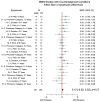Meta-analysis and systematic review of the literature characterizing auditory mismatch negativity in individuals with autism
- PMID: 29408312
- PMCID: PMC5845770
- DOI: 10.1016/j.neubiorev.2018.01.008
Meta-analysis and systematic review of the literature characterizing auditory mismatch negativity in individuals with autism
Abstract
A number of past studies have used mismatch negativity (MMN) to identify auditory processing deficits in individuals with autism spectrum disorder (ASD). Our meta-analysis compared MMN responses for individuals with ASD and typically developing controls (TD). We analyzed 67 experiments across 22 publications that employed passive, auditory-based MMN paradigms with ASD and TD participants. Most studies lacked design characteristics that would lead to an accurate description of the MMN. Variability between experiments measuring MMN amplitude was smaller when limited to studies that counterbalanced stimuli. Reduced MMN amplitude was found among young children with ASD compared to controls and in experiments that used nonspeech sounds. Still, few studies included adolescents or those with below-average verbal IQ. Most studies suffered from small sample sizes, and aggregating these data did not reveal significant group differences. This analysis points to a need for research focused specifically on understudied ASD samples using carefully designed MMN experiments. Study of individual differences in MMN may provide further insights into distinct subgroups within the heterogeneous ASD population.
Keywords: Auditory processing; Autism; Event-related potential; MMF; MMN; Meta-analysis; Mismatch field; Mismatch negativity; Oddball; Systematic review.
Copyright © 2018 Elsevier Ltd. All rights reserved.
Figures





Similar articles
-
Auditory processing in autism spectrum disorder: Mismatch negativity deficits.Autism Res. 2017 Nov;10(11):1857-1865. doi: 10.1002/aur.1821. Epub 2017 Jun 22. Autism Res. 2017. PMID: 28639417
-
Mismatch negativity to different deviant changes in autism spectrum disorders: A meta-analysis.Clin Neurophysiol. 2020 Mar;131(3):766-777. doi: 10.1016/j.clinph.2019.10.031. Epub 2020 Jan 1. Clin Neurophysiol. 2020. PMID: 31952914
-
Impaired P1 Habituation and Mismatch Negativity in Children with Autism Spectrum Disorder.J Autism Dev Disord. 2020 Feb;50(2):603-616. doi: 10.1007/s10803-019-04299-0. J Autism Dev Disord. 2020. PMID: 31728809
-
Auditory processing deficit in individuals with dyslexia: A meta-analysis of mismatch negativity.Neurosci Biobehav Rev. 2020 Sep;116:396-405. doi: 10.1016/j.neubiorev.2020.06.032. Epub 2020 Jun 29. Neurosci Biobehav Rev. 2020. PMID: 32610180 Review.
-
The Mismatch Negativity: An Indicator of Perception of Regularities in Music.Behav Neurol. 2015;2015:469508. doi: 10.1155/2015/469508. Epub 2015 Oct 4. Behav Neurol. 2015. PMID: 26504352 Free PMC article. Review.
Cited by
-
A Preliminary Study Characterizing Subcortical and Cortical Auditory Processing and Their Relation to Autistic Traits and Sensory Features.J Autism Dev Disord. 2024 Jan;54(1):75-92. doi: 10.1007/s10803-022-05773-y. Epub 2022 Oct 13. J Autism Dev Disord. 2024. PMID: 36227444 Free PMC article.
-
Resting-state EEG power differences in autism spectrum disorder: a systematic review and meta-analysis.Transl Psychiatry. 2023 Dec 14;13(1):389. doi: 10.1038/s41398-023-02681-2. Transl Psychiatry. 2023. PMID: 38097538 Free PMC article.
-
Increased context adjustment is associated with auditory sensitivities but not with autistic traits.Autism Res. 2022 Aug;15(8):1457-1468. doi: 10.1002/aur.2759. Epub 2022 May 24. Autism Res. 2022. PMID: 35607992 Free PMC article.
-
Abnormal auditory mismatch fields are associated with communication impairment in both verbal and minimally verbal/nonverbal children who have autism spectrum disorder.Autism Res. 2019 Aug;12(8):1225-1235. doi: 10.1002/aur.2136. Epub 2019 May 28. Autism Res. 2019. PMID: 31136103 Free PMC article.
-
Magnetoencephalography Research in Pediatric Autism Spectrum Disorder.Neuroimaging Clin N Am. 2020 May;30(2):193-203. doi: 10.1016/j.nic.2020.01.001. Epub 2020 Mar 27. Neuroimaging Clin N Am. 2020. PMID: 32336406 Free PMC article. Review.
References
-
- American Psychiatric Association. Diagnostic and statistical manual of mental disorders (DSM-5®) American Psychiatric Pub; 2013.
-
- Andersson S, Posserud MB, Lundervold AJ. Early and late auditory event-related potentials in cognitively high functioning male adolescents with autism spectrum disorder. Research in Autism Spectrum Disorders. 2013;7(7):815–823. doi: 10.1016/j.rasd.2013.03.007. - DOI
Publication types
MeSH terms
Grants and funding
LinkOut - more resources
Full Text Sources
Other Literature Sources
Medical
Miscellaneous

